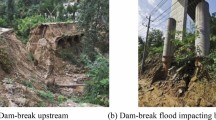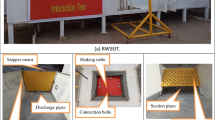Abstract
In order to clarify the influence of hydrodynamic on dynamic response of bridge with complex piers submerged in reservoir, based on the continuous beam of a 4-column pile column frame pier in Xiaolangdi Reservoir of Yellow River, taking 4-column pile column frame pier and bridge as the object separately, the numerical analysis model of bridge (pier) - water interaction is established by ANSYS. The flow around deep-water piers is analyzed. For the single pier (SP) and the pier of the bridge (BP), the dynamic responses of different flow velocities, water depths and wave heights and the combined action are studied. The research shows that detouring flow analysis shows that velocity field and pressure field of each column are asymmetric. Specifically, for this bridge, due to the columns interfere with each other, the velocity difference of 1#, 4# column is more obvious than that of 2#, 3# column. Maximum and stability values of the dynamic response of SP and BP increase with the increase of flow velocity and depth. Specifically, as the water flow velocity increases, the maximum response of the dynamic response increases linearly, while the stable response of the dynamic response increases in the form of a quadratic curve. When the water depth does not exceed 50 m, the maximum and stable values of the dynamic response gradually increase in the form of a quadratic curve. When the wave acts alone, the dynamic response of SP and BP is the largest at the wave crest and the smallest at the wave trough. The maximum dynamic response at the wave crest and trough increases with the increase of wave height. With the increase of water depth, the dynamic effects of waves on SP and BP are more significant. Under the combined action of wave and current, the dynamic response of SP and BP increases with the increase of wave height and water depth. For different flow velocities, the maximum value of dynamic response at wave crest increases with the increase of flow velocity, and the maximum absolute value of dynamic response at wave trough decreases with the increase of flow velocity. Dynamic response under the combined action of wave and current is not the superposition of the dynamic response under the separate action of wave and current. The maximum value of dynamic response appears in wave crest and wave trough, indicating that the current does not change the action of wave field, and the wave still plays a leading role. Specifically, the influence of water on the dynamic response of BP is: pier bottom bending moment > pier bottom shear force > pier top displacement and the influence of water on the dynamic response of SP is: pier bottom bending moment > pier top displacement > pier bottom shear force.
Similar content being viewed by others
References
Bai X (2017) Study on the seismic response feature of deepwater bridge pier wave-current environment. MSc Thesis, Beijing Jiaotong University, Beijing, China (in Chinese)
Chen B, Huang C (1997) Nonlinear hydrodynamic pressures generated by a moving high-rise offshore cylinder. Ocean Engineering 24(3): 201–216, DOI: https://doi.org/10.1016/S0029-8018(96)00022-4
Chu Y, Li R, Li X (2022) Analysis of seismic response of the arch bridge across reservoir considering fluid-solid coupling effect. Shock and Vibration 3873935, DOI: https://doi.org/10.1155/2022/3873935
Fenerci A, Kvale KA, Xiang X, Oiseth O (2022) Hydrodynamic interaction of floating bridge pontoons and its effect on the bridge dynamic responses. Marine Structures 83:103174, DOI: https://doi.org/10.1016/j.marstruc.2022.103174
Frantzis C, Grigoriadis D, Dimas AA (2020) An efficient Navier-Stokes based numerical wave tank using fast Poisson solvers and the immersed boundary method. Ocean Engineering 196, DOI: https://doi.org/10.1016/j.oceaneng.2019.106832
Huang B, Ren Q, Cui X, Zhang J, Zhu B (2020) Study of wave forces acting on the box-girder superstructure of coastal bridges in the submerged condition based on potential flow theory. Advances in Bridge Engineering 1(1), DOI: https://doi.org/10.1186/s43251-020-00018-3
Guo Q (2019) Study on numerical model and nonlinear seismic response of deep water bridge with high piers under fluid-structure interaction. MSc Thesis, Wuhan University of Technology, Wuhan, China (in Chinese)
Huang X, Li Z (2011) Influence of hydrodynamic pressure on seismic response of bridge piers in deep water. China Civil Engineering Journal 44(1):1–9, DOI: https://doi.org/10.15951/j.tmgcxb.2011.01.001
Isaacson M, Mathai T, Mihelcic C (1989) Hydrodynamic coefficients of a vertical circular cylinder. Canadian Journal of Civil Engineering 17(3):302–310, DOI: https://doi.org/10.1139/190-037
Jiang H, Bai X, Huang L, Li C, Meng X, Yang Q (2019) Seismic response characteristics of deep-water piers of sea-crossing bridges in wave-current environment. Journal of the China Railway Society 41(3): 117–127, DOI: https://doi.org/10.3969/j.issn.1001-8360.2019.03.016
Esandi JM, Buldakov E, Simons R, Stagonas D (2020) An experimental study on wave forces on a vertical cylinder due to spilling breaking and near-breaking wave groups. Coastal Engineering 162, DOI: https://doi.org/10.1016/j.coastaleng.2020.103778
Kitamura Y, Sakurai S (1985) Dynamic stiffness under rigid rectangular foundations resting on an elastic two-layered medium. Doboku Gakkai Ronbunshu (362):391–396, DOI: https://doi.org/10.2208/jscej.1985.362_391
Liu E, Chen W, Lin Y, Wang S, Li Y (2021) Numerical simulation of flow around a two-dimensional elliptical cylinder with different Reynolds numbers. Chinese Journal of Applied Mechanics 38(5):2025–2031, DOI: https://doi.org/10.11776/cjam.38.05.A072
Li J, Wang A, Yang D, Li S, Zhang J, Zhang C (2022) Analysis of influence of wave and current on dynamic response of continuous beam with four - column frame piers in reservoir area. Journal of Kunming University of Science and Technology (Natural Science) 47(4): 145–155, DOI: https://doi.org/10.16112/j.cnki.53-1223/n.2022.04.482
Liaw CY, Chopra AK (1974) Dynamics of towers surrounded by water. Earthquake Engineering & Structural Dynamics 3(1):33–49, DOI: https://doi.org/10.1002/eqe.4290030104
Lu H (2013) Research on the applicable scope of morison equation method in seismic response analysis of deep water bridges. MSc Thesis, Beijing Jiaotong University, Beijing, China (in Chinese)
Lu H, Zhou Z, Zheng X (2017) Seismic response analysis of round-end hollow bridge piers in deep water based on fluid unit method. Architecture Technology 48(4):353–356, DOI: https://doi.org/10.13731/j.issn.1000-4726.2017.04.004
Matemu C, Crowley R, Resio D (2020) Development of a one-way coupled diffraction/trapped air model for predicting wave loading on bridges under water wave attack. Journal of Fluids and Structures, 97:103067, DOI: https://doi.org/10.1016/j.jfluidstructs.2020.103067
Mccormick ME (1989) Hydrodynamic coefficients of a monolithic circular offshore structure. Earthquake Engineering & Structural Dynamics 18(2):199–216, DOI: https://doi.org/10.1002/eqe.4290180206
Morison JR, O’Brien MP, Johnson JW (1950) The force exerted by surface waves on piles. Journal of Petroleum Technology 2(5):149–154, DOI: https://doi.org/10.2118/950149-G
Savage JL (1939) Earthquake studies for pit river bridge. Civil Engineering 9(8):470–472
Stokes GG (1847) On the theory of oscillatory waves. Transactions of the Cambridge Philosophical Society 8:441–455
Su M (2021) Yellow river yearbook. Beijing: Yellow River Yearbook Society of the Yellow River Water Resources Commission of the Ministry of Water Resources 67–76
Tran-Ngoc H, Khatir S, Le-Xuan T, De Roeck G, Bui-Tien T, Abdel Wahab M (2022) Finite element model updating of a multispan bridge with a hybrid metaheuristic search algorithm using experimental data from wireless triaxial sensors. Engineering with Computers 38(Suppl 3): S1865–S1883, DOI: https://doi.org/10.1007/s00366-021-01307-9
Wang D, Wang B, Gao W, Ye J, Wahab MA (2022a) Dynamic contact behaviors of saddle materials for suspension bridge. Engineering Failure Analysis 134:106031, DOI: https://doi.org/10.1016/j.engfailanal.2022.106031
Wang D, Ye J, Wang B, Wahab MA (2021) Review on the service safety assessment of main cable of long span multi-tower suspension bridge. Applied Sciences 11(13):5920, DOI: https://doi.org/10.3390/app11135920
Wang D, Zhu H, Xu W, Ye J, Zhang D, Abdel WM (2022b) Contact and slip behaviors of main cable of the long-span suspension bridge. Engineering Failure Analysis 136:106232, DOI: https://doi.org/10.1016/j.engfailanal.2022.106232
Wei K, Qin S, Zhao W, Zhu B, Xu G (2021) State-of-the-art review of bridge hydrodynamics in 2020. Journal of Civil and Environmental Engineering 43(S1):31–42, DOI: https://doi.org/10.11835/j.issn.2096-6717.2021.204
Wei K, Yang X, Liu Q, Jiang M, Zhou C (2020) Numerical analyses of current load of large bridge caisson during its sinking process. Railway Standard Design 64(11):62–67, DOI: https://doi.org/10.13238/j.issn.1004-2954.201911010005
Westergaard H M (1933) Water pressures on dams during earthquakes. Transactions of the American Society of Civil Engineers 98(2):418–432
Wu A (2017) Study on hydrodynamic forces on substructure of deep-water bridge under combined loadings of wave-currents and earthquakes. PhD Thesis, Southwest Jiaotong University, Chengdu, Chinas (in Chinese)
Xu B, Wei K, Qin S, Hong J (2020) Experimental study of wave loads on elevated pile cap of pile group foundation for sea-crossing bridges. Ocean Engineering 197(s1):106896, DOI: https://doi.org/10.1016/j.oceaneng.2019.106896
Yang W (2012) Study on hydrodynamic analysis method of deep-water bridges. PhD Thesis, Southwest Jiaotong University, Chengdu, China (in Chinese)
Yang D (2022) Hydrodynamic and seismic response analysis of complex piers in reservoir area based on fluid-structure interaction. MSc Thesis, Zhengzhou University, Zhengzhou, China (in Chinese)
Yang W, Li Q (2013) The expanded morison equation considering inner and outer water hydrodynamic pressure of hollow piers. Ocean Engineering 69(sep.1): 79–87, DOI: https://doi.org/10.1016/j.oceaneng.2013.05.008
Zhao Q, Li C, Dong S (2019) Research status and prospect of seismic response of deep-water bridge pier. Journal of Traffic and Transportation Engineering 19(2):1–13, DOI: https://doi.org/10.19818/j.cnki.1671-1637.2019.02.001
Zhu D, Dong Y (2020) Experimental and 3D numerical investigation of solitary wave forces on coastal bridges. Ocean Engineering 209, DOI: https://doi.org/10.1016/j.oceaneng.2020.107499
Acknowledgments
This work was supported by Transportation Science and technology planning project of Henan Province, China (No.2021J2). The editors and the anonymous reviewers are gratefully acknowledged. Their comments greatly improved the paper.
Author information
Authors and Affiliations
Corresponding author
Rights and permissions
About this article
Cite this article
Li, J., Xu, B., Yang, D. et al. Influence of Hydrodynamic Effect on Dynamic Response of Bridge with Complex Piers Submerged in Reservoir. KSCE J Civ Eng 27, 4728–4743 (2023). https://doi.org/10.1007/s12205-023-0880-8
Received:
Revised:
Accepted:
Published:
Issue Date:
DOI: https://doi.org/10.1007/s12205-023-0880-8




